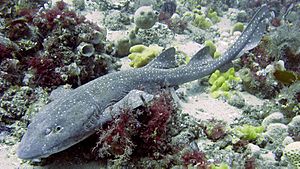Brachaelurus facts for kids
Quick facts for kids Brachaelurus |
|
|---|---|
 |
|
| A Blind Shark (Brachaelurus waddi) | |
| Scientific classification |
|
| Kingdom: | Animalia |
| Phylum: | Chordata |
| Class: | Chondrichthyes |
| Order: | Orectolobiformes |
| Family: | Brachaeluridae Applegate, 1974 |
| Genus: | Brachaelurus Ogilby, 1908 |
| Type species | |
| Chiloscyllium modestum Günther, 1872
|
|
Blind sharks, known scientifically as Brachaelurus, are a fascinating type of shark. They are the only members of their family, called Brachaeluridae. These unique sharks get their common name because they often close their eyes when caught by people, likely to protect them. But don't worry, they can see perfectly well!
You can find these sharks living in the shallow coastal waters off the eastern coast of Australia. They usually stay in waters up to about 110 meters (360 feet) deep.
Contents
Discovering Blind Sharks: What Makes Them Special?
Blind sharks have some cool features that help them stand out. They have long, whisker-like parts called barbels near their mouths. These barbels help them sense food in the dark or murky water. They also have large holes behind their eyes, called spiracles, which help them breathe. A special groove around their nostrils is another unique trait.
Physical Features: Fins and Tail
These sharks have two dorsal fins, which are the fins on their back. These fins are placed quite close together. They also have a relatively short tail compared to some other shark species.
What Do Blind Sharks Eat?
Blind sharks are carnivores, meaning they eat other animals. Their diet includes small fish, cuttlefish, sea anemones, and various crustaceans like crabs and shrimp. They are skilled hunters in their underwater homes.
How Do Blind Sharks Reproduce?
Female blind sharks have a special way of reproducing. They keep their eggs safely inside their bodies until the baby sharks hatch. This process is called ovoviviparity. During this time, the developing embryos get all their food from the yolk inside their eggs. Once they are ready, the live young emerge from the mother.
Types of Blind Sharks: Species You Should Know
There are two main types of blind sharks that are alive today. Both are found in the waters around Australia.
- Brachaelurus colcloughi (also known as the bluegrey carpetshark)
- Brachaelurus waddi (this is the true blind shark)
Scientists have also found evidence of at least one ancient blind shark species from fossils. This species is named Brachaelurus estesi. It helps us understand the history of these sharks.
Blind Sharks in Aquariums: A Peek Behind the Glass
Both the blind shark and the bluegrey carpetshark have been successfully kept in home aquariums. They are quite popular because they stay relatively small as adults. They also enjoy finding cozy, tight spaces to hide in, which makes them interesting to watch.
Life in Captivity
In an aquarium setting, these sharks can live for a long time, sometimes up to 20 years! However, they are mostly inactive during the day. They prefer to spend their daylight hours hiding in artificial caves or other sheltered spots.
Feeding and Care in Aquariums
Aquarium owners feed blind sharks a diet of fresh and frozen seafood. They usually get fed about three times a week. Keeping the water temperature between 18-24 degrees Celsius (64-76 degrees Fahrenheit) is best for their health. It's important to know that blind sharks might try to eat any smaller tankmates they can swallow.
Breeding Programs
Some aquariums have even had success with blind sharks reproducing in captivity. For example, the Sydney Aquarium has a successful breeding colony of blind sharks. This helps scientists learn more about these amazing creatures and their life cycle.

